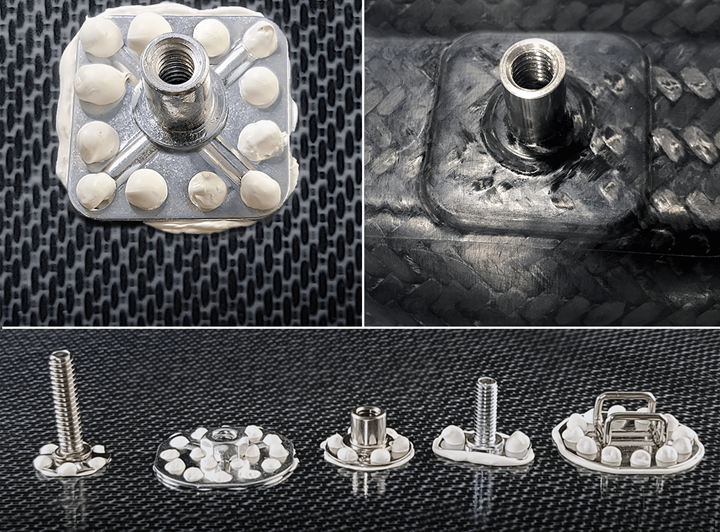High-strength, nondestructive adhesive-bonded fasteners
CAMX 2023: Rotaloc bonding fasteners come in a variety of baseplate styles, threads, sizes and materials for high-strength, nondestructive bonding with fiber-reinforced composites and thermoset/thermoformed plastics.
Rotaloc International (Littleton, Colo., U.S.) bonding fasteners are designed for use with fiber-reinforced plastic (FRP) composite materials, including fiberglass, carbon fiber and thermoset/thermoformed plastics. Rotaloc says bonding fasteners can be adhesively bonded-on, or molded-in during the layup process. A bonding fastener’s baseplate distributes load over a broad area. Perforations enable resin or adhesive to flow through, creating a high-strength mechanical bond. Adhesive-mounted bonding fasteners provide a high-strength and nondestructive fastener solution for composites, reportedly reducing cost, waste and production time.
Rotaloc produces a wide variety of bonding fasteners in varying baseplate styles, threads, sizes and materials. The threads available include Male Threaded Stud (M1), Male Threadless Stud (M4), Female Threaded Nut (F1), Female Threaded Collar (F2) and Threadless Wire Loops (M7). Each of these is available in numerous thread types, materials, baseplate styles and sizes, according to the company. Rotaloc says it also provides in-house design and engineering, capable of creating custom bonding fasteners tailored to specific projects.
Because different environments demand different material properties, Rotaloc produces bonding fasteners in various materials ranging from zinc-plated carbon steel to stainless steel to brass. Platings and finishes are said to provide the company’s bonding fasteners with added corrosion resistance for more extreme environments. Some finishes Rotaloc offers include Powder Coating, E-Coating, Zinc-Nickel Plating, Trivalent-Zinc Plating, Hot-Dip Galvanizing and Passivating. Rotaloc also offers heat treatment and manufacturer-specific plating and treatment processes as well.
Rotaloc’s bonding fasteners span across several different industries. Manufacturers in the marine industry, for example, use the fasteners to mount insulation panels, instrument clusters, windows, cabling, wiring, fluid lines and to affix fiberglass hulls or other composite paneling. In transportation, they’re used to mount interior wiring, panels, insulation, light fixtures, circuit boards and other mechanical components. Exterior uses include mounting fluid tanks, fender flares, side skirts, rear air diffusers, front air dams, hood/trunk mounts or body kits. According to Rotaloc, the same bonding fastener could see countless different uses, from architectural cladding, to under-sink mounts on granite counters, to wind turbines and honeycomb panels.
Related Content
-
Jeep all-composite roof receivers achieve steel performance at low mass
Ultrashort carbon fiber/PPA replaces steel on rooftop brackets to hold Jeep soft tops, hardtops.
-
Manufacturing the MFFD thermoplastic composite fuselage
Demonstrator’s upper, lower shells and assembly prove materials and new processes for lighter, cheaper and more sustainable high-rate future aircraft.
-
A new era for ceramic matrix composites
CMC is expanding, with new fiber production in Europe, faster processes and higher temperature materials enabling applications for industry, hypersonics and New Space.














